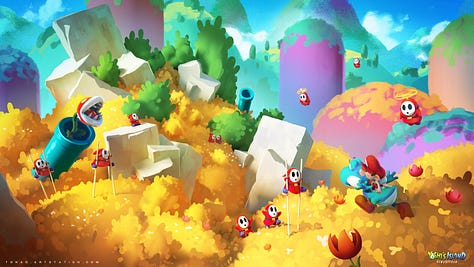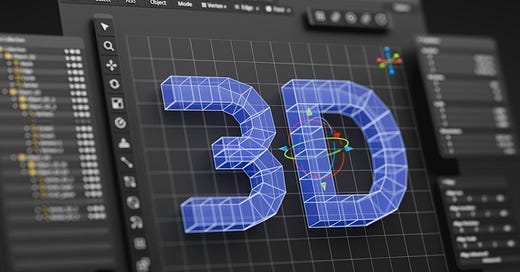When I first started learning about 3D in the early 2000s, I was definitely aware of CAD. I knew it for 2 things…
All the Industrial Design students used CAD to visualize their incredible designs.
One of my fellow art students took a 3D scan of his unborn child, converted it to a CAD file, and 3D printed it.
One of those use cases was inspiring…the other still gives me nightmares.
But for all of the cool designs CAD was visualizing, I couldn’t help but think that, even then, the models looked a little boxy, low-res, and dated even at that time. So when I entered the world of animation, I forgot about CAD since I assumed it would have been replaced along the way.
I was very wrong.
After taking the job at Substance 3D/Adobe, I started working more and more with non-entertainment companies using CAD data from anything from automotive design to architecture to fashion. And the stuff they were creating was pretty rad. So while I think 3D modeling will undergo a fundamental shift in the next few years, I’m not completely convinced that CAD designs will go away. So I thought I would take a minute to research the history of CAD to understand how it might continue to develop.
Also, I’m hoping this new knowledge will replace that 3D print of that fetus in my memory…
The Early Days of CAD
The first CAD software was developed in the 1960s by Ivan Sutherland, a computer scientist at MIT. His software, called Sketchpad, allowed users to create and manipulate 2D drawings using a light pen. Sketchpad was groundbreaking in computer graphics and paved the way for future CAD systems.
In the early 1970s, a company called ComputerVision developed the first commercial CAD system, which was used primarily for electronic design automation. This system allowed designers to create 2D drawings and simulate how they function in a circuit.
3D Modeling Emerges
In the late 1970s, wireframe modeling emerged as a technology that allowed designers to create 3D models on the computer. Wireframe modeling enabled designers to create 3D objects by connecting lines and vertices in a virtual space. Wireframe models were simple but provided a way for designers to visualize objects in three dimensions, which significantly improved over 2D drawings.
One of the first 3D modeling systems was developed by Applicon, a company whose system, called "Applicon Bravo," was released in 1977 and used primarily for designing automotive parts. Applicon Bravo allowed designers to create wireframe models of car parts and then use those models to create detailed drawings for manufacturing.
The Rise of 2D and 3D CAD Systems
In 1982, Autodesk released AutoCAD, which quickly became the standard for 2D drafting. AutoCAD allowed designers to create accurate and precise drawings quickly and easily. However, it wasn't until Autodesk's 3D Studio was released in 1990 that 3D modeling became widely accessible to designers.
AutoDesk's 3D Studio allowed designers to create complex 3D models using a combination of wireframe modeling and surface modeling techniques. The software was used primarily for creating 3D animations and visual effects for films and television shows. However, it quickly became popular among architects and engineers who used it to create 3D models of buildings and mechanical parts.
In the mid-1990s, a new type of 3D modeling technology emerged called solid modeling. Solid modeling allowed designers to create 3D objects with solid surfaces rather than just wireframes or surfaces. Solid modeling significantly improved over earlier 3D modeling techniques, allowing designers to create more complex and realistic models.
One of the first solid modeling systems was developed by Parametric Technology Corporation (PTC). Their Pro/Engineer system was released in 1987 and became popular among engineers and designers. Pro/Engineer allowed designers to create complex 3D models of mechanical parts, which could be used for manufacturing.
In the early 2000s, another solid modeling system called SolidWorks was released. SolidWorks was designed to be easy to use and accessible to designers who were not experts in 3D modeling. SolidWorks quickly became popular among small businesses and startups, which used it to create 3D models of their products.
The Impact of CAD 3D Modeling
The impact of CAD 3D modeling has been significant. It has transformed every aspect of design, engineering, and architecture. 3D modeling has allowed designers to create more complex and realistic models, enabling them to design more efficient, cost-effective, and visually appealing products.
CAD 3D modeling has also increased collaboration between designers, engineers, and manufacturers. With 3D models, designers can easily share their designs with others, allowing for faster prototyping and manufacturing. 3D modeling has also improved communication between designers and clients, as clients can visualize the final product before it is built.
Furthermore, 3D modeling has allowed designers to explore new possibilities quickly and easily. Using virtual simulations and analysis tools, designers can test and refine their designs before building physical prototypes, reducing the cost and time required for product development.
.
In addition to the benefits of 3D modeling for product design, it has also revolutionized the fields of architecture and construction. Architects can use 3D modeling to create detailed digital models of buildings, which can be used for visualization, simulation, and analysis. These models can also generate accurate construction documents and manage the construction process.
Overall, CAD 3D modeling has been a game-changer for many industries. And although I think newer technologies like AI generative models and SDK modeling will upend the modeling world in the next few years, CAD modeling has proven time and time again to be an incredibly resilient and useful tool for many industries.
3D News of the Week
A roundup of interesting 3D related news you may have missed this week.
Epic Games releases Twinmotion 2023.1 - cgchannel.com
Wonder Dynamics in Action - twitter.com
Experimenting With Techniques for Stylized Art in UE5 - 80.lv
Stray: Giving Character to a Futuristic City in Substance 3D - Adobe Blog
AI Generative Fashion Videos - fxguide.com
Artist of the Week









3D Tutorials
Another shameless plug…I’m creating an Intro to Substance 3D Painter course! Check out my big overview intro showing a quick rundown of the entire process of creating a materialized asset in Substance Painter.
3D Job Spreadsheet
Link to Google Doc With A TON of Jobs in Animation (not operated by me)
Michael Tanzillo has been a Senior Artist on animated films at Blue Sky Studios/Disney with credits including three Ice Age movies, two Rios, Peanuts, Ferdinand, Spies in Disguise, and Epic. Currently, Michael is a Head of Technical Artists with the Substance 3D Growth team at Adobe.
In addition to his work as an artist, Michael is the Co-Author of the book Lighting for Animation: The Visual Art of Storytelling and the Co-Founder of The Academy of Animated Art, an online school that has helped hundreds of artists around the world begin careers in Animation, Visual Effects, and Digital Imaging.
www.michaeltanzillo.com
Free 3D Tutorials on the Michael Tanzillo YouTube Channel
Thanks for reading The 3D Artist! Subscribe for free to receive new posts and support my work. All views and opinions are my own!
**Note - Some of this article was written with the aid of ChatGPT









